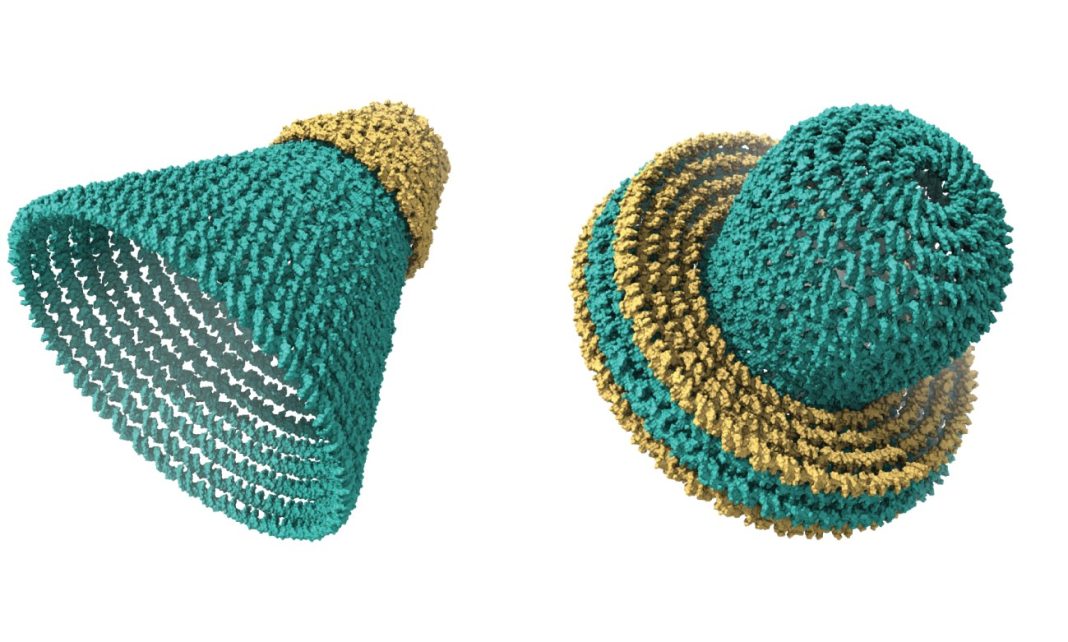DNA origami, a fascinating technology that uses algorithms to design self-assembling 2- and 3D nanostructures using DNA helices, has added a new member to its growing catalog: multilayered capsule-like 3D shapes with smooth, non-rasterized, curves. The ability to design layered and curved geometries could be a game changer for nanofabrication, molecular signaling, medical imaging, and drug delivery.

Details of DNA origami’s upgraded toolkit were published in Science Advances (“Automated Design of 3D DNA Origami With Non-Rasterized 2D Curvature”). Daniel Fu, a student of computer science at Duke University, and Raghu Pradeep Narayanan, PhD, a postdoctoral researcher at the University of California, San Francisco (UCSF), are co-lead authors of the study, and Hao Yan, PhD, director and professor at the center for biodesign and biomimetics at Arizona State University, and John Reif, PhD, professor of computer science at Duke University are the senior authors of the study.
“It’s a big step forward in terms of automated design of novel three-dimensional structures,” said Reif.
DNA origami has been around since the 1980s. The first 3D shapes employed block design principles on DNA to create cubes, pyramids, and soccer balls. Such traditional strategies restricted the different shapes that could be generated because DNA helices had to be straight and parallel to a common vector. Advances in design strategies proposed the use of curved DNA helices that were better suited to generate capsule-like structures that align more closely with natural globular molecules while retaining enclosed spaces for compartmentalized molecular interactions.
Experts agreed that multilayered, stable, fully enclosed, ball-like DNA nanostructures, manufacturable at high yields, had distinct benefits, but the complexity of designing such structures made them inaccessible to most researchers. Curved structures attempted in earlier studies were mostly single-layered which limited their mechanical rigidity and use. Designing capsules within capsules, like a Russian doll, using DNA, requires the ability to bend and fold long threads of DNA helices into complex 3D shapes with nanoscale precision.
The current study develops and automates a set of new design principles for multilayered closed and curved DNA nanostructures by introducing an open-source CAD (computer-aided design) software, DNAxiS, for shapes with axial symmetry. The software automates the tedious and lengthy workflows required to design curves and lets users transform their drawings or digital models of curved shapes into 3D DNA nanostructures.
DNAxiS works by coiling a long DNA double helix into concentric rings that stack on each other to form the contours of a 3D shape, like using coils of yarn to make a basket. To lend sturdiness to the structures, the team reinforced them with additional layers. Implementing multilayer design principles (a functionality called “reinforcement”) increases the yield and stability of these rounded DNA structures.
“DNAxiS is the first CAD software tool implementing probabilistic algorithms to perform crossover selection and the first for the design of capsule-like curved DNA nanostructures, with a specific focus on those with axial symmetry,” the authors noted.

Using DNAxiS researchers can make cones, gourds, and clover-leaf shapes, among others. The key to designing stable DNA nanostructures is the placement of short DNA “staples” that hold the longer DNA coils together. “If there are too few, or if they’re in the wrong position, the structure won’t form correctly,” said Fu. “Before our software, the curvature of the shapes made this an especially difficult problem.”
DNAxiS generates a list of DNA strands that could potentially self-assemble into an intended shape. The researchers then synthesize and mix the strands in a test tube and allow them to self-assemble by heating and cooling the cocktail.
Future investigations based on the current work may generalize and optimize methods for designing shapes with greater complexity and motivate the search for innovative applications of such biomimetic nanostructures in labs and clinics.


